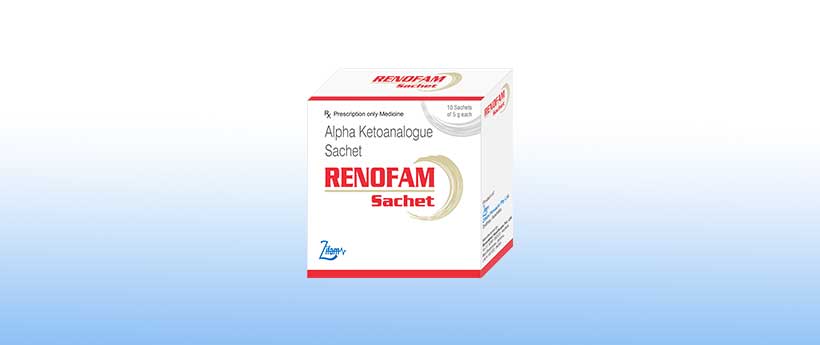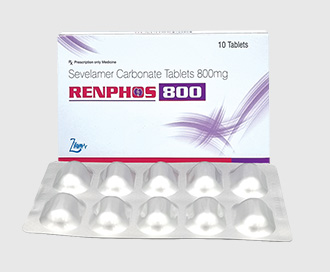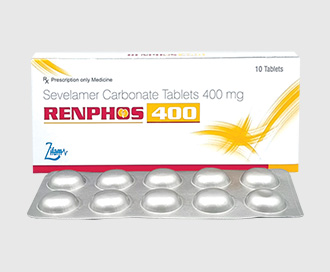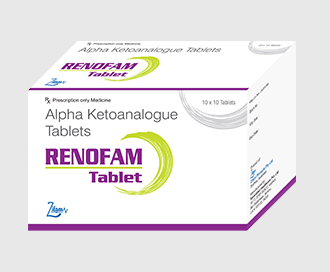RENOFAM SACHET
- ENG
- မြန်မာ

RENOFAM
RENOFAM SACHET
(Alpha ketoanalogue Sachet)
Composition:
Each sachet per serving contains:
Calcium-3-methyl-2-oxo-valerate (Alpha ketoanalogue to isoleucine, calcium salt) ……………….. 201 mg
Calcium-4-methyl-2-oxo-valerate (Alpha ketoanalogue to leucine, calcium salt) ……………………. 303 mg
Calcium-2-oxo-3-phenylpropionate (Alpha ketoanalogue to phenylalanine, calcium salt) ………. 204 mg
Calcium-3-methyl-2-oxo-butyrate (Alpha ketoanalogue to valine, calcium salt) …………………….. 258 mg
Calcium-DL-2-hydroxy-4-(methylthio)-butyrate (Alpha hydroxyanalogue to methionine, calcium salt) … 177 mg
L-Lysine acetate USP ……………………………………………………………………………………………………….. 315 mg
L-Threonine USP …………………………………………………………………………………………………………….. 159 mg
L-Tryptophan USP …………………………………………………………………………………………………………… 69 mg
L-Histidine USP ………………………………………………………………………………………………………………. 114 mg
L-Tyrosine USP ……………………………………………………………………………………………………………….. 90 mg
Excipients ……………………………………………………………………………………………………………………….. q.s
Colour :- Approved Colour used in Sachet
INDICATIONS:
Prevention and treatment of damages due to faulty or deficient protein metabolism in chronic kidney disease in connection with a limited dietary protein intake of 40 g/day or less (adult).
Recommended Dosage
For Oral Use
Renofam Sachet
The suggested dose can be 40 mg/kg body weight. One to Two sachets daily.
Adding Ketoanalogue to very low protein (40 g per day) diets for patients with chronic kideny disease (CKD stage I, II, III), generally in patients with glomerular filtration rate (GFR) less than 25 ml/min., significantly reduces the progression of kidney disease in the predialysis period and delays dialysis initiation.
Used for prevention and treatment of deficient protein metabolism in chronic renal insufficiency.
Duration – as long as the GFR is between 5 and about 15 mL/min
Pharmacodynamics
Pharmacotherapeutic group: Amino acids, including combinations with polypeptides.
ATC code: Vo6DD
RENOFAM are administered for nutrition therapy in chronic kidney disease.
RENOFAM allows the intake of essential amino acids while minimising the amino-nitrogen intake. Following absorption, the keto- and hydroxy-analogues are transaminated to the corresponding essential amino acids by taking nitrogen from non-essential amino acids, thereby decreasing the formation of urea by re-using the amino group. Hence, the accumulation of Uraemic toxins is reduced. Keto and hydroxy acids do not induce hyperfiltration of the residual nephrons. Ketoacid containing supplements exert a positive effect on renal hyperphosphataemia and secondary hyperparathyroidism. Moreover, renal osteodystrophy may be improved. The use of RENOFAM in combination with a very low protein diet allows to reduce nitrogen intake while preventing the deleterious consequences of inadequate dietary protein intake and malnutrition.
Pharmacokinetics
The plasma kinetics of amino acids and their integration in the metabolic pathways are well established. It should nevertheless be noted that in Uraemic patients, the cause of the changed plasma levels, which occur frequently in these patients, does not seem to be the absorption of the supplied amino acids, i. e. the absorption itself is not disturbed. The changed plasma levels seem to be due to impaired post-absorptive kinetics, which can be detected in a very early stage of the disease. In healthy individuals, the plasma levels of ketoacids increase within 10 min after oral administration. Increases of up to the 5-fold the baseline levels are achieved. Peak levels occur within 20-60 min, and after 90 min levels stabilise in the range of the base levels. Gastrointestinal absorption is thus very rapid. The simultaneous increases in the levels of the ketoacids and the corresponding amino acids show that the ketoacids are transaminated very rapidly. Due to the physiological utilisation pathways of ketoacids in the body it is likely that exogenously supplied ketoacids are very rapidly integrated into the metabolic cycles. Ketoacids follow the same catabolic pathways as classical amino acids. No specific study on ketoacid excretion has been performed to date.
Method of administration:
For Oral administration only.
CONTRAINDICATIONS
The use of this medicine is contra-indicated in the following cases:
− Hypersensitivity to the active substances or to any of the excipients
− Hypercalcaemia
− Disturbed amino acid metabolism
WARNINGS AND PRECAUTIONS
The serum calcium level should be monitored regularly. Ensure sufficient calorie intake. No experience has been gained so far with the administration in paediatric patients. In the presence of hereditary phenylketonuria, attention should be given to the fact that RENOFAM contains phenylalanine. Monitoring of the serum phosphate levels is needed in case of concomitant administration of aluminium hydroxide.
Effects on ability to drive and use machines
RENOFAM has no influence on the ability to drive and use machines.
Interactions with Other Medicaments
Concomitant administration of calcium-containing drugs may cause or aggravate elevated serum calcium levels. Drugs that form hardly soluble compounds with calcium (e.g. tetracycline’s, quinolines such as ciprofloxacin and norfloxacin as well as drugs containing iron, fluoride or estramustine) should not be taken at the same time with RENOFAM SACHET to avoid disturbed absorption of the active substances. An interval of at least two hours should elapse between the ingestion of RENOFAM SACHET and these drugs. The susceptibility to cardioactive glycosides, and hence the risk for arrhythmia will increase if RENOFAM SACHET produces elevated serum calcium levels. Uraemic symptoms improve under therapy with RENOFAM SACHET. Thus, in case of aluminium hydroxide administration, the dose of this drug has to be reduced if necessary. Serum phosphate levels should be monitored for a decrease.
Statement on Usage during Pregnancy and Lactation
There are no adequate data from the use of RENOFAM in pregnant women. Animal studies do not indicate direct or indirect harmful effects with respect to pregnancy, embryonal/foetal development, parturition or postnatal development. Caution should be exercised when prescribing to pregnant women. No experience has been made so far with the use during lactation.
Adverse Effects/UNDESIRABLE EFFECTS
Adverse effect frequencies are ranked as follows:
Very common (≥ 1/10)
Common (≥ 1/100 to < 1/10)
Uncommon (≥ 1/1,000 to < 1/100)
Rare (≥ 1/10,000 to < 1/1,000)
Very rare (<1/10,000)
Not known (cannot be estimated from the available data)
Metabolism and nutrition disorders
Very rare: hypercalcaemia
If hypercalcaemia occurs, the intake of vitamin D should be reduced. In case of persisting hypercalcaemia, the dose of RENOFAM as well as the intake of any other calcium sources has to be reduced.
OVERDOSAGE and Treatment
No case of overdose has been reported.
PACKAGING:
Sachets:
5g x 10 Sachets in unit carton along with pack insert.
Storage Condication:
Store below 30°C. Protect from light and moisture.
Keep all the medicines out of reach of children.
Shelf Life
24 Months from the date of manufacturing
Manufactured by:
Ravenbhel Healthcare Pvt. Ltd.
16-17, EPIP, SIDCO, Kartholi, Bari Brahmana,
Jammu, J&K-181133, INDIA.
Product of:
Zifam Pinnacle Pty Ltd.,
Sydney, Australia








